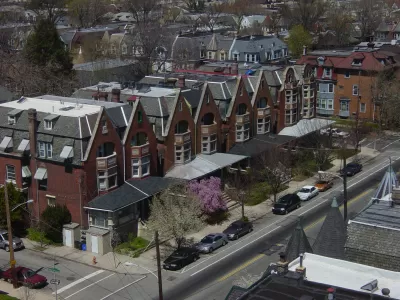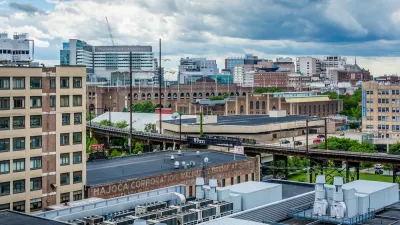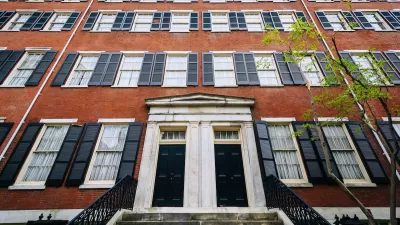The proposal would hold builders accountable for damage incurred to adjacent homes as historic rowhouse properties see increased redevelopment.

A bill proposed in the Philadelphia city council "would require builders to have general liability insurance that protects adjacent properties during construction or demolition." Writing in Temple University's Philadelphia News, Thomas Riese reports that the bill "would make builders accountable for damage that some homeowners have grappled with for years, sometimes without knowing where to turn for compensation."
Advocates of the bill say it would be a first step in protecting homeowners from damage and preventing dangerous practices, but "would like to see more protections passed as laws that could serve as a 'Neighbors Bill of Rights.'" Community activist Drew Miller "said he’d like to see more collaboration between city departments, especially before project permits are approved."
The city's Department of Licenses and Inspection "currently has 69,529 open requests or complaints, and roughly 32% of those pertain to building structures, licenses, and construction." In part due to the architecture of Philadelphia's iconic rowhouses, adjacent property damage is "frustratingly predictable," according to historic preservation professional Starr Herr-Cardillo. "On a rowhouse block, when they’re built at the same time, they’re one structure." In many cases, demolition requires underpinning, a process designed to reinforce the foundation and prevent instability in the surrounding buildings.
"Philadelphia has encouraged a development boom that spurred its economic growth, but residents and homeowners want to make sure they’re not taken advantage of along the way."
FULL STORY: Council proposal would add protections for adjacent property construction

Study: Maui’s Plan to Convert Vacation Rentals to Long-Term Housing Could Cause Nearly $1 Billion Economic Loss
The plan would reduce visitor accommodation by 25,% resulting in 1,900 jobs lost.

North Texas Transit Leaders Tout Benefits of TOD for Growing Region
At a summit focused on transit-oriented development, policymakers discussed how North Texas’ expanded light rail system can serve as a tool for economic growth.

Why Should We Subsidize Public Transportation?
Many public transit agencies face financial stress due to rising costs, declining fare revenue, and declining subsidies. Transit advocates must provide a strong business case for increasing public transit funding.

How to Make US Trains Faster
Changes to boarding platforms and a switch to electric trains could improve U.S. passenger rail service without the added cost of high-speed rail.

Columbia’s Revitalized ‘Loop’ Is a Hub for Local Entrepreneurs
A focus on small businesses is helping a commercial corridor in Columbia, Missouri thrive.

Invasive Insect Threatens Minnesota’s Ash Forests
The Emerald Ash Borer is a rapidly spreading invasive pest threatening Minnesota’s ash trees, and homeowners are encouraged to plant diverse replacement species, avoid moving ash firewood, and monitor for signs of infestation.
Urban Design for Planners 1: Software Tools
This six-course series explores essential urban design concepts using open source software and equips planners with the tools they need to participate fully in the urban design process.
Planning for Universal Design
Learn the tools for implementing Universal Design in planning regulations.
City of Santa Clarita
Ascent Environmental
Institute for Housing and Urban Development Studies (IHS)
City of Grandview
Harvard GSD Executive Education
Toledo-Lucas County Plan Commissions
Salt Lake City
NYU Wagner Graduate School of Public Service





























